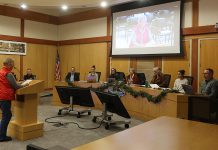Across the county, crops of all varieties are running two to
three weeks behind schedule, thanks to an unusually deep and
consistent marine layer.
“We’re running about three weeks late,” Gayle Sullivan of Dry
Creek Peach & Produce said. “Whereas the bulk of our fruit
usually comes in August, this year it’s going to be September. The
flavor and quality is there, but the timing is pushed back.”
Other orchards, produce farms, and vineyards are faring
similarly.
“Last year, I was here selling apples at the end of July. And
this is my very first week,” apple farmer Don Winset of Winset’s
Wild Haven said over the weekend.
“Figs are at a standstill. The table grapes are very slow. I’m
usually selling table grapes by now,” said Sharon Vyborne of
Vyborne Farm, gesturing to her produce stand, which bore no table
grapes.
July 2010 was the coldest since 1987. The National Oceanic &
Atmospheric Administration’s weather station at the Santa Rosa
airport reported the mean July temperature to be 65.4 F, and only
one day out of the entire month made it above 90 degrees. Only
seven days out of the month were reported as fair, while 21 days
were partly cloudy and foggy.
So far, August has not been much warmer. In Sebastopol, the
Western Weather Group’s weather station reported an average
temperature of 58.4 degrees through August 16. Alexander Valley was
slightly warmer at 62.9 degrees.
“This has certainly been the summer of the deep marine layer,”
said meteorologist Marc Walsh, who specializes in agricultural
forecasting for the Western Weather Group. “Especially in the last
month, the marine layer has been remarkably persistent at 2,000
feet or deeper, which is unusual for that length of time. Usually
it’s only 1,000 or 1,500 feet.”
The marine layer is the primary control over summer heat—or in
the case of this summer, the lack thereof. Temperatures within the
marine layer are typically around 60 degrees, while above the
marine layer they reach into the 80s.
“Our temperatures are completely controlled by the depth of the
marine layer,” Walsh noted. “That’s basically all forecasters look
at during the summer. Unfortunately, the model data isn’t that
good, with regards to what that marine layer does. It’s a very
fickle thing.”
A deep marine layer—in other words, a 2,000-foot thick layer of
coastal fog—enables the cool, dense air mass to reach further
inland and linger there for a longer time. This summer’s deep
marine layer is the result of a general long wave troughing
pattern, or series of low pressure zones.
The root cause of the low pressure pattern is uncertain, but
farmers are certainly well aware of the effects. “The average
summer fog burn off is probably at 10 or 11 in the morning, but
this year it’s been 12 or 1,” farmer Winset said.
The marine layer’s persistence has translated into a slow
farmers market season. Many farmers and backyard gardeners are just
now starting to harvest their first heirloom tomatoes, and even
crops that are typically associated with cool weather have been
slow to grow.
“Even the lettuce slows down a little,” said Ed Miller of Carrot
Top Farm, who is known for his farm-fresh greens. “The quality is
very good, though. Overall the weather is all right for us.”
For other farmers, the unusual weather can be a bit
nervewracking. Sonoma County Winegrape Commission President Nick
Frey estimated that harvest would be two to three weeks later than
usual, with most vineyards falling in the two week category.
“I think sparkling wine will probably be harvested in that last
week of August, or maybe the first days of September,” Frey said.
“And I think that with the still wines everything’s going to start
coming in about the same time.”
Some grapegrowers are trying to hasten harvest. Longtime
grapegrower Gary Blasi, who grows produce and grapes in the Chalk
Hill area, said that he was pulling fruit in an attempt to help it
ripen more quickly.
“The Chalk Hill Chardonnay, we’re pulling fruit to help ripen it
up. We’re also pulling bunches off because of berries with
botrytis,” Blasi said.
A late harvest isn’t bad for grapes — unless fall rains and
weather come early.
“The unknown right now is whether we’ll get an Indian summer in
September or October, where we get some sunshine and heat. We need
some heat to dry up the botrytis fungus because it’s still lying
there,” Frey said. “The other critical thing is rain. Hopefully the
rains will not begin before normal. If it were around the 10th or
15th of November for rain, that would be great.”
Unfortunately, last winter’s El Niño has yielded to a La Niña
weather pattern, and current long-range forecasts are calling for
fall to be wetter than usual.
“In a La Niña weather pattern, the Pacific Northwest has above
normal precipitation and Southern California is really dry. We’re
in between, and the current long range calls for above average
precipitation in the late fall and early winter, from the bay area
northward,” Walsh said. “As we go past January, then we drop to
below normal for Northern California.”
And will there be an Indian summer, as many farmers and
grapegrowers are hoping?
“It’s hard to say something like that, but I would say the
tendency would probably be to rain early. Maybe we’ll see a couple
systems earlier than normal, but foreseeing that is difficult,”
Walsh said.








